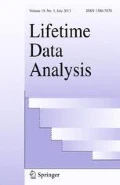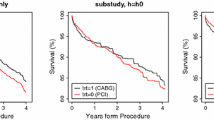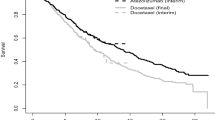Abstract
When observational data are used to compare treatment-specific survivals, regular two-sample tests, such as the log-rank test, need to be adjusted for the imbalance between treatments with respect to baseline covariate distributions. Besides, the standard assumption that survival time and censoring time are conditionally independent given the treatment, required for the regular two-sample tests, may not be realistic in observational studies. Moreover, treatment-specific hazards are often non-proportional, resulting in small power for the log-rank test. In this paper, we propose a set of adjusted weighted log-rank tests and their supremum versions by inverse probability of treatment and censoring weighting to compare treatment-specific survivals based on data from observational studies. These tests are proven to be asymptotically correct. Simulation studies show that with realistic sample sizes and censoring rates, the proposed tests have the desired Type I error probabilities and are more powerful than the adjusted log-rank test when the treatment-specific hazards differ in non-proportional ways. A real data example illustrates the practical utility of the new methods.


Similar content being viewed by others
References
Fleming TR, Harrington DP (1981) A class of hypothesis tests for one and two sample censored survival data. Commun Stat Theory Methods 10(8):763–794
Fleming TR, Harrington DP (1991) Counting processes and survival analysis. Wiley, New York
Gill R (1980) Censoring and stochastic integrals. Mathematical Centre Tracts, Mathematisch Centrum. https://books.google.com/books?id=Qh7vAAAAMAAJ
Prentice RL (1978) Linear rank tests with right censored data. Biometrika 65(1):167–179. doi:10.1093/biomet/65.1.167, http://biomet.oxfordjournals.org/content/65/1/167.abstract, http://biomet.oxfordjournals.org/content/65/1/167.full.pdf+html
Schaubel DE, Wei G (2011) Double inverse-weighted estimation of cumulative treatment effects under nonproportional hazards and dependent censoring. Biometrics 67(1):29–38. doi:10.1111/j.1541-0420.2010.01449.x
Tsiatis A (2006) Semiparametric theory and missing data. Springer, Berlin
van der Vaart AW, Wellner JA (1996) Weak convergence and empirical processes. Springer, Berlin
Xie J, Liu C (2005) Adjusted Kaplan–Meier estimator and log-rank test with inverse probability of treatment weighting for survival data. Stat Med 24(20):3089–3110. doi:10.1002/sim.2174
Zhang M, Schaubel DE (2012) Double-robust semiparametric estimator for differences in restricted mean lifetimes in observational studies. Biometrics 68(4):999–1009. doi:10.1111/j.1541-0420.2012.01759.x
Acknowledgements
This work was partially supported by National Institute of Dental and Craniofacial Research Grant 1R03DE023889. The kidney transplant data used here have been supplied by the Minneapolis Medical Research Foundation (MMRF) as the contractor for the Scientific Registry of Transplant Recipients (SRTR). The interpretation and reporting of these data are the responsibility of the author and in no way should be seen as an official policy of or interpretation by the SRTR or the U.S. Government.
Author information
Authors and Affiliations
Corresponding author
Appendices
Appendix A
1.1 A.1. Notations and regularity conditions
We introduce the following notations that will be used in the regularity conditions below and the proof of Theorem 2:
and \(S_{0j}^C(t)\) denotes the conditional survival function of C given \(Z=j\) and \({\mathbf {X}}^C={\mathbf {0}}\) for \(j=0,1\) and \(d=0,1,2\), where for a column vector \({\mathbf {b}}\), \({\mathbf {b}}^{\otimes 2}={\mathbf {b}}{\mathbf {b}}^T\), \({\mathbf {b}}^{\otimes 1}={\mathbf {b}}\), and \({\mathbf {b}}^{\otimes 0}=1\). The rest notations appearing in Theorems 1 and 2 will be introduced as we prove Theorem 2.
We assume the following regularity conditions for \(i=1,\ldots ,n\) and \(j=0,1\):
-
(a)
Model (2) for treatment assignment is correctly specified.
-
(b)
Model (4) for censoring is correctly specified.
-
(c)
\({\mathbf {X}}_i^Z\) is bounded almost surely.
-
(d)
\(V_Z({\varvec{\alpha }})\) is positive definite at the true value of \({\varvec{\alpha }}\).
-
(e)
\({\mathbf {X}}_i^C\) is bounded almost surely.
-
(f)
\(\varOmega _j^C({\varvec{\theta }}_j)\) is positive definite at the true value of \({\varvec{\theta }}_j\).
-
(g)
\(S_{(j)}(t)\) is absolutely continuous in t.
-
(h)
\(S_{0j}^C(t)\) is absolutely continuous in t.
-
(i)
As \(n\rightarrow \infty \), \(W(s)\xrightarrow {p}w(s)\) uniformly on \(\mathcal {I}\), where w(s) is a nonnegative, left-continuous function with right-hand limits on \(\mathcal {I}\) such that \(w(s)<\infty \) and its right-continuous adaptation \(w^+\) has bounded variation on each closed subinterval of \(\mathcal {I}\).
Conditions (a), (c) and (d) ensure the consistency and asymptotic normality of \(\hat{{\varvec{\alpha }}}\). Conditions (b), (e) and (f) ensure the uniform consistency of \(\hat{\varLambda }_{ij}^C(\cdot )\) over \([0,t_{\sup }]\) and the weak convergence of \(\sqrt{n}\{\hat{\varLambda }_{ij}^C(\cdot )-\varLambda _{ij}^C(\cdot )\}\) to a zero-mean Gaussian process on \(D[0,t_{\sup }]\). Conditions (g) and (h) ensure that \(\exp \{-\hat{\varLambda }_{(j)}(\cdot )\}\) and \(\exp \{-\hat{\varLambda }_{ij}^C(\cdot )\}\) are consistent estimators for \(S_{(j)}(\cdot )\) and \(S_{ij}^C(\cdot )\) respectively given the consistency of \(\hat{\varLambda }_{(j)}(\cdot )\) and \(\hat{\varLambda }_{ij}^C(\cdot )\). Condition (i) is needed for weak convergence of \(W_a(t;\hat{{\varvec{\alpha }}},\hat{{\varvec{\varLambda }}}^C)\) to a zero-mean Gaussian process on \(D[0,t_{\sup }]\) under \(H_0\).
1.2 A.2. Proof of Theorem 2
We first decompose \(W_a(t;\hat{{\varvec{\alpha }}},\hat{{\varvec{\varLambda }}}^C)\) as follows.
By algebra, \(W_a(t;{\varvec{\alpha }},{\varvec{\varLambda }}^C)\) can be written as
Define \(D_j(s;{\varvec{\alpha }},{\varvec{\varLambda }}^C)\equiv E\left[ [p_{ij}({\varvec{\alpha }})\exp \{-\varLambda _{ij}^C(s-)\}]^{-1}Y_{ij}(s)\right] \) \((j=0,1)\) and \(D(s;{\varvec{\alpha }},{\varvec{\varLambda }}^C)\equiv \sum _{j=0}^1 D_j(s;{\varvec{\alpha }},{\varvec{\varLambda }}^C)\). Applying the Law of Large Number, then using conditions (a), (b), (h) and (i), when \(n\rightarrow \infty \), we can re-express \(W_a(t;{\varvec{\alpha }},{\varvec{\varLambda }}^C)\) as
with \(E\{A_{ij}(t;{\varvec{\alpha }},{\varvec{\varLambda }}^C)\}=0\) \(j=(0,1)\).
To obtain the asymptotic expressions of the second and third summands in (16), we first derive the asymptotic expressions of \(\sqrt{n}(\hat{{\varvec{\alpha }}}-{\varvec{\alpha }})\) and \(\sqrt{n}\{\hat{\varLambda }_{ij}^C(t)-\varLambda _{ij}^C(t)\}\).
Under conditions (a), (c) and (d), we have from standard maximum likelihood theory \(\hat{{\varvec{\alpha }}}\xrightarrow {p}{\varvec{\alpha }}\) and
where \({\varvec{\psi }}_i^Z({\varvec{\alpha }})=\tilde{{\mathbf {X}}}_i^Z\{Z_i- expit ({\varvec{\alpha }}^T\tilde{{\mathbf {X}}}_i^Z)\}\).
Under conditions (b), (e) and (f), standard partial likelihood theory Fleming and Harrington (1991) leads to \(\hat{{\varvec{\theta }}}_j\xrightarrow {p}{\varvec{\theta }}_j\),
where \(U_{ij}^C({\varvec{\theta }}_j)=\int _0^\infty \{{\mathbf {X}}_i^C-\bar{{\mathbf {x}}}_j^C(t;{\varvec{\theta }}_j)\}dM_{ij}^C(t)\), and
for \(j=0,1\). We express \(\sqrt{n}\{\hat{\varLambda }_{ij}^C(t)-\varLambda _{ij}^C(t)\}\) as
Using a Taylor expansion,
By algebra, a Taylor expansion around \({\varvec{\theta }}_j\), the Law of Large Number, the consistency of \(\hat{{\varvec{\theta }}}_j\), and (21),
Combining (20) (22), (23) and (24), we get
where \(K_{ij}(t;{\varvec{\theta }}_j)=\int _0^t\{{\mathbf {X}}_i^C-\bar{{\mathbf {x}}}_j^C(s;{\varvec{\theta }}_j)\}d\varLambda _{ij}^C(s)\).
Now consider \(W_a(t;\hat{{\varvec{\alpha }}},\hat{{\varvec{\varLambda }}}^C)-W_a(t;{\varvec{\alpha }},\hat{{\varvec{\varLambda }}}^C)\) in (16). Using Taylor expansion around \({\varvec{\alpha }}\), root-n consistency of \(\hat{\varLambda }_{ij}^C(\cdot )\), the Law of Large Number and condition (i), then substituting (19), after a lot of algebra, we obtain
where
and
for \(j=0,1\).
Next consider \(W_a(t;{\varvec{\alpha }},\hat{{\varvec{\varLambda }}}^C)-W_a(t;{\varvec{\alpha }},{\varvec{\varLambda }}^C)\) in (16). Using Taylor expansions around \(\varLambda _{ij}^C(\cdot )\) \((i=1,\ldots ,n,j=0,1)\), the Law of Large Number and condition (i), then substituting (25), after a lot of algebra, we obtain
where
and
for \(j=0,1\).
Finally, substituting (18), (26) and (27) into (16) completes the proof of Theorem 2.
Appendix B: Assessment of the Cox models for censoring time of the SRTR data
See Fig. 3.
Rights and permissions
About this article
Cite this article
Li, C. Two-sample tests for survival data from observational studies. Lifetime Data Anal 24, 509–531 (2018). https://doi.org/10.1007/s10985-017-9408-1
Received:
Accepted:
Published:
Issue Date:
DOI: https://doi.org/10.1007/s10985-017-9408-1





